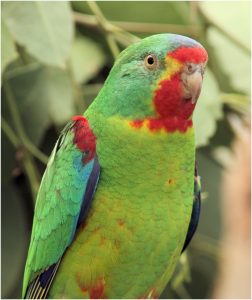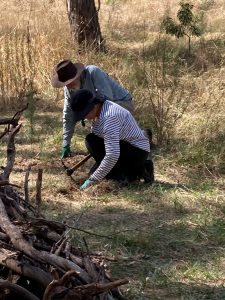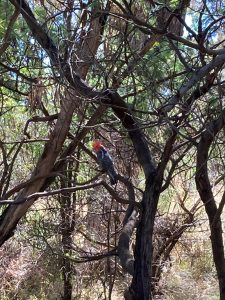In February we held a successful working bee on the southern side of the tank watercourse. In March we will be working on the northern side: Come and help to free the planted Blackthorns and other native shrubs of their outgrown guards and the smothering weeds.
The area provides a habitat for our feathered friends including the endangered Gang-gang Cockatoo and the critically endangered Swift Parrot, as well as skinks, frogs and invertebrates.
Since 2005, Swift Parrots, on their annual migration tour from their breeding sites in Tasmania to mainland Australia visit regularly at the area along the water course near the Hackett water tank where they take baths, sip water and feast on the nectar of the autumn-flowering Bundy trees that grow nearby.
Let’s get the area in tip-top condition before the Swift Parrots arrive this autumn.
When: Sunday 19 March 2023, 9 am to 12 noon; give as much time as you can spare.
Where: Meet at the watercourse close to the water tank off Rivett Street and French Street intersection, Hackett; view this map.
What: Dismantling guards, hand-weeding highly invasive Chilean Needle Grass around planted native Blackthorn and other planted shrubs along the drainage edge and seedlings of Ivy and Japanese Honeysuckle in the drainage ditch; placing wood chip mulch around the plantings in a doughnut pattern to suppress future weed growth.
Bring and wear: Sun protection, long sleeves and pants, sturdy shoes or gum boots and gloves if you have them.
Inquiries: secretary@majura.org
You need no experience to attend this event. Instructions, tools, some gloves, hand sanitiser and a delicious home-baked cake will be provided.
Please click on this link for further information on the Friends of Mt Majura drainage line project.
Habitat for endangered species Gang-gang Cockatoo and Swift Parrot
The watercourse is the bottom part of one of Mount Majura’s major drainages which starts high up on the mountain near the summit. It provides habitat for a vast range of wildlife including the endangered species Gang-gang Cockatoo, Callocephalon fimbriatum and Swift Parrot, Lathamus discolor. Drainage lines will act as important wildlife refuge sites in Climate Change.

Swift Parrot (G.Dabb). For more images and information visit Canberra Nature Map or Canberra Ornithologists Group
Swift Parrots regularly visit the area on their annual migration tour from breeding sites in Tasmania to mainland Australia. They can be spotted along the tank overflow, where they feed on the nectar of autumn flowering Bundy, Eucalyptus goniocalyx and take a bath (in which they indulge excessively preferably in groups). In 2005 and 2008 the critically endangered species visited the area in record numbers which draw large crowds of people who ventured to Mt Majura to glimpse one of Australia’s rarest parrots.
Daniel Iglesias, then manager of Parks and Conservation Service in his address to the media in 2005 referred to the large number of Swift parrots visiting Mt Majura and noted: “This really puts the Mt Majura sighting in perspective, and re-affirms how precious the ACT system of woodland reserves is to species such as the Swift Parrot.”




